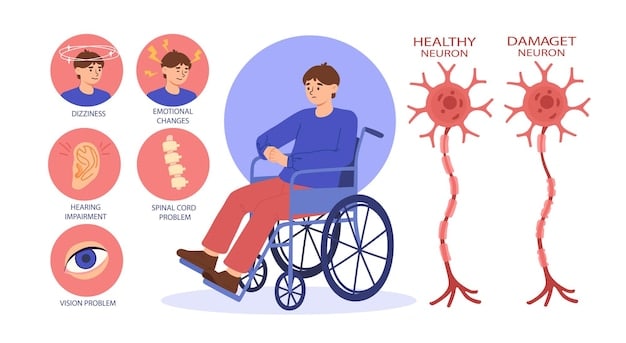The crippling illness known as motor neurone disease (MND) affects the body’s ability to move, breathe, and swallow. It causes muscle weakness and frequently has a life-shortening prognosis. Although MND can affect people of any age, it is most frequently diagnosed in people over 50. The absence of a conclusive treatment is still a significant obstacle in spite of the disease’s complexity and severity. However, there is still hope because the battle against MND is far from over and new approaches to symptom management are being made possible by ongoing research and treatment advancements.
MND is thought to be caused by a confluence of lifestyle, environmental, and genetic factors, though the exact cause is still mostly unknown. Even though genetic mutations account for only 10% of cases, research into these causes is still being conducted, and new discoveries could lead to a better understanding of the disease and, eventually, its prevention. Although a cure has not yet been found, the main goal of current treatment options is to slow the progression of symptoms. The goal is still to improve the quality of life for people with MND while the medical community looks for solutions.
| Category | Details |
|---|---|
| Condition | Motor Neurone Disease (MND) |
| Symptoms | Muscle weakness, twitching, cramps, speech and swallowing difficulties, fatigue, mood changes, loss of mobility |
| Causes | Genetic mutation (familial MND), environmental, and lifestyle factors |
| Diagnosis | Physical examination, MRI, blood tests, muscle biopsy, electromyography (EMG), nerve conduction studies |
| Treatment | Riluzole (slows progression), multidisciplinary care including occupational therapy, speech therapy, physiotherapy, and nutritional support |
| Prognosis | No cure, life expectancy typically 2-3 years post diagnosis, but some patients live longer with appropriate care |
| Management | Use of mobility aids, feeding tubes, ventilators, communication devices, home care, and palliative care as necessary |
| Support Organizations | MND Australia, ALS Association, local neurological societies |
| Website for Reference | mndaustralia.org.au |
The Tragic Signs of MND: Essential Information
Individual differences exist in the symptoms that motor neurone disease manifests. Muscle twitches, cramps, or weakness, especially in the hands and legs, are common early symptoms that make simple activities painful, such as climbing stairs or holding an object. Because MND can mimic less serious conditions in its early stages, timely medical attention is essential for a proper diagnosis.
More incapacitating symptoms appear as MND worsens. Patients frequently struggle with breathing, swallowing, and speaking, all of which have a big influence on day-to-day living. For many, the illness advances quickly, and people may become less mobile or independent. The significance of early diagnosis and intervention is highlighted by this sobering reality. Despite the lack of a cure, symptom management—including the use of drugs like riluzole—can slow the disease’s progression and give patients more time to spend with their loved ones.
MND’s Causes and Diagnosis Remain Unsolved
Although the precise cause of MND is still unknown, a number of factors play a role in its development. A family history of MND is not present in about 90% of cases, which are categorized as sporadic. However, familial MND, which is inherited and passed down through generations, is caused by genetic mutations in the remaining 10% of cases. In an effort to find avoidable triggers, researchers are still examining the intricate relationship between genetic predispositions and environmental factors.
MND diagnosis is frequently a difficult and drawn-out procedure. MND initially exhibits symptoms that are comparable to those of numerous other, less severe medical disorders. To rule out other illnesses and confirm a diagnosis, doctors use a range of tests, such as electromyography (EMG), MRI scans, and blood work. Since the symptoms of MND frequently resemble those of other neurological disorders, this diagnostic procedure may take some time.
Reversing the Trend Against MND in Treatment and Management
Although there is currently no proven cure for MND, there are treatment options that can help patients manage their symptoms and enhance their quality of life. Although it is not a cure, riluzole, the first medication approved by the FDA for MND, has demonstrated promise in slowing the disease’s progression. For people who already have the illness, riluzole can prolong survival by several months, which can be especially helpful. Although edaravone has not yet received approval for use in all areas, it has been investigated more recently as a potential alternative to slow the disease’s progression.
For patients with MND, a multidisciplinary approach to care is crucial in addition to medication. This covers nutritional support as well as therapies to help with speech, swallowing, and mobility. While speech pathologists offer techniques to improve communication, occupational therapists assist patients in modifying their homes to meet their changing needs. In order to provide patients and their families with emotional support as they deal with the difficulties of living with MND, psychologists and social workers must be involved.
Investigations and the Search for a Cure
Scientists, medical professionals, and patients all have hope and determination for the continued search for a cure for MND. The treatment of MND appears to have a bright future thanks to recent developments in gene therapy and immunotherapy. Engineered regulatory T cells, or eTregs, were shown to have promise as a cell-based treatment for MND in 2025. These treatments might eventually provide a revolutionary cure, changing the lives of people afflicted by this terrible illness.
The support systems for people with MND are just as vital as the ongoing search for a cure. For people with MND, groups like MND Australia are essential in offering advocacy, support, and resources. There is still great hope for a better future for MND patients thanks to the combined efforts of researchers, medical professionals, and advocacy organizations.

